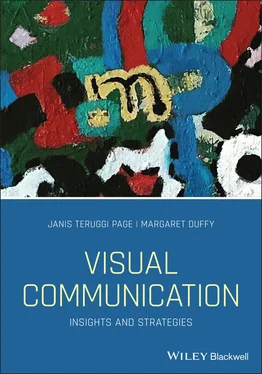Library of Congress Cataloging‐in‐Publication Data
Names: Page, Janis Teruggi, author.| Duffy, Margaret, author.
Title: Visual communication: insights and strategies / Janis Teruggi Page, University of Illinois, Chicago. Margaret Duffy, University of Missouri, Columbia, USA
Description: First edition. | Hoboken, NJ : Wiley Blackwell, 2022. | Includes bibliographical references and index.
Identifiers: LCCN 2020043378 (print) | LCCN 2020043379 (ebook) | ISBN 9781119226475 (paperback) | ISBN 9781119227298 (adobe pdf) | ISBN 9781119227304 (epub)
Subjects: LCSH: Visual communication. | Visual analytics.
Classification: LCC P93.5 .D86 2021 (print) | LCC P93.5 (ebook) | DDC 302.2/26–dc23
LC record available at https://lccn.loc.gov/2020043378LC ebook record available at https://lccn.loc.gov/2020043379
Cover Design: Wiley
Cover Images: © Janet Trierweiler
How can we make sense of the myriad visual images surrounding us today? How can we strategically use images with a clear understanding of their function and impact?
This book answers these questions by providing new “ways of seeing” visual representations through different lenses and in different contexts. It then provides practical guidance for creating purposeful and ethical visual communication.
The authors recognize the accelerating dominion of images in communication, society, and culture. We human beings process images and video effortlessly and automatically. Visuals carry an emotional and visceral punch that text can rarely, if ever, match. As multinational marketers, social media influencers, and teenagers on TikTok know, visuals create their own language, accessible to all, regardless of traditional textual barriers of understanding such as education or language.
We've watched as entertainment and information have morphed into largely image‐based communication including advertising and brand messaging, organizational communication, and individual creation and uploading of images, memes, and videos of all kinds. As of this writing in early 2021, people are watching 5 billion YouTube vides every day and Instagram has over one billion users worldwide. U.S. digital advertising expenditures are projected to grow to 22.18 billion U.S. dollars in 2021 (https://www.statista.com/statistics/256272/digital‐video‐advertising‐spending‐in‐the‐us/).
Most of us take the sphere of images for granted: it's just the way the world is. Of course, human beings have always created symbolic structures of meaning that shape how we interpret and participate in social life. However, we also tend to treat these image systems as natural phenomena. We conveniently forget that we ourselves invented these structures of meaning and it's important we understand their significance and meaning in more thoughtful and nuanced ways.
For some years, we've been conducting research on images, moving and still, and their various roles in society. We've studied and written about digital visual folklore in emails about President Obama, the widespread sharing of memes of football star Richard Sherman, comedy television's performance of vice presidential debates, presidential candidates' online visual storytelling, images of morality in political TV ads and news coverage, sexual imagery in advertising, issues in visual persuasion ethics, photographic coverage of the Pope's 2015 visit to Cuba, ethical implications of VR, AR, and 360 °technologies, and satiric images of Trump as spectacle in global magazines, among other visual topics.
Inspired by our previous work, we wrote this book for students and scholars with the intent of providing insights into the role of visuals in our dynamic social environment. Ralph Waldo Emerson said, “We are symbols and we inhabit symbols” ( The Poet , 1844). We hope this book connects with a broad range of scholars and practitioners in the arts, humanities, social sciences, engineering, technology, and neuroscience and serves as an invitation to future study.
Both authors made generous contributions in the research and writing of this book. As this project has evolved through its various phases, there are many people to whom we owe special thanks.
We would like to begin by thanking our academic colleagues in visual communication for inspiring and challenging us to create this book and extend our theoretical, applied approach to visual communication education to students in all preprofessional fields that encounter visual phenomena.
Many thanks to the anonymous reviewers who offered clear critique, advice, and suggestions based on their own teaching experiences in visual communication. We also benefited greatly from our students who, through classroom engagement, provided helpful feedback on lessons and exercises.
We want to acknowledge our colleagues and administrators at the University of Illinois at Chicago, Department of Communication, and the Novak Leadership Institute at Missouri School of Journalism for their support during the research and writing of this book.
We also deeply appreciate the contributions from the professionals and academics who shared insightful profiles in our chapters and who offered their suggestions and ideas as we developed the outline of the book.
Drawing from years of study and practice in fine art, Janis is especially grateful for the long‐term mentoring in visual metaphors by Sr. Alyce Van Acker, O.P., of the Fine Line Creative Arts Center, St. Charles, IL.
Finally, we would like to thank our spouses William Page and Daryl Moen for their constant encouragement throughout our long process of shaping and perfecting each chapter, resulting in a work we are truly proud of.
Janis Teruggi Pageis a faculty member in the Department of Communication, University of Illinois at Chicago, and has been affiliated with the Strategic Public Relations Master’s Program, George Washington University, for more than a decade. She has taught visual communication courses throughout her academic career. As a Fulbright distinguished chair, in 2018 she researched intercultural visual communication and taught visual literacy at Masaryk University, Brno, Czech Republic. An award‐winning author, her research includes “Images with Messages: A Semiotic Approach to Identifying and Decoding Strategic Visual Communication,” published in the Routledge Handbook of Strategic Communication (2015), and “Trump as Global Spectacle: The Visual Rhetoric of Magazine Covers,” published in the Handbook of Visual Communication (2020). She is also coauthor of the textbook Introduction to Public Relations: Strategic, Digital, and Socially Responsible Communication (2019, 2021) with Lawrence J. Parnell. Prior to joining academia, she had a 20‐year career as creative and marketing director for various US media companies. A former student at the School of the Art Institute, Chicago, she holds a PhD from the Missouri School of Journalism with a secondary emphasis in art history.
Margaret Duffyis Professor of Strategic Communication and cofounder and executive director of the Novak Leadership Institute. She led the effort to obtain a $21.6 million gift to endow the Institute from David Novak, alumnus of the Missouri School of Journalism advertising program. Mr. Novak is the retired CEO of YUM! Brands (Pizza Hut, Taco Bell, and KFC) and credits his education in advertising as the catalyst for his leadership success. Until 2016, Dr. Duffy chaired the Strategic Communication Faculty at the Missouri School of Journalism. She also served as associate dean for graduate studies. Dr. Duffy directed the Missouri School of Journalism's Online Master’s Program from 2001 to 2016. An award‐winning scholar, her research focuses on leadership, organizational communication, visual communication, and persuasion ethics. She coedited the book Persuasion Ethics Today (2016) and cowrote Advertising Age: The Principles of Advertising and Marketing Communication at Work (2011), Dr. Duffy is a founding board member of the Institute for Advertising Ethics and an inaugural fellow at the Donald W. Reynolds Journalism Institute. In 2019, she received the University of Missouri Distinguished Faculty Award. She is a former marketing executive and earned her PhD from the University of Iowa. An author and consultant, Dr. Duffy conducts research and advises media companies and brands around the world with clients as varied as Estée Lauder and the US Army.
Читать дальше












